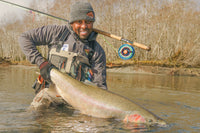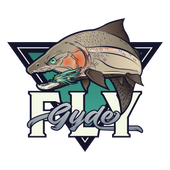Connecting with an anadromous fish on the swing is one of the most gratifying experiences available in fly fishing. Spey Fishing is a technique chosen not for effectiveness, amongst others. Above all, it is selected for the tight line grab. This chance of satisfaction from the abrupt disruption of serenity surrounding you when a connection is secured draws anglers from around the world. Swinging a fly is performed with a single-hand or double-hand rod. However, most commonly, the technique is executed with a double-hand rod using the Spey Casting method.
The technique of Spey Fishing began in the 1800s and derived from its origin on the River Spey located in Scotland. Are you new to Spey Fishing or looking for a better understanding of what to do on the water? If yes, please continue reading to assist with the comprehension of a few key points. At Fly Gyde, we encourage you to become a more informed angler; as a result, this enables an enjoyable experience on the water with our partners or us.
Different casts enable you to reach your target within a river. These also assist with casting around obstacles, your wading depth, or casting into a Fly Fisherman’s enemy, the wind. Roll casting, which you may be familiar with from casting a single-hand rod, is where you begin but with assistance from your bottom hand placed on the lower handle of your Spey Rod. Firstly, the Roll Cast starts your casting journey and takes you into casts such as the Single Spey, Double Spey, Snap C, Snap T, Snap Z, Snake Roll, or Perry Poke. Secondly, all mentioned casts begin with a line placement on the water called an anchor.
Most importantly, to comprehend is that an anchor allows you to load your rod into a flexed position, which then assists with your cast. Without a proper load built into the rod from correct anchor placement, effective casts cannot be achieved. Another critical step in casting Spey Rods & Lines is executing a fully formed D-Loop. The D-Loop is a round-shaped back loop of the line between the rod tip and the anchor. As a result of forming a proper D-Loop, energy is transferred into your rod and line toward your rear after anchor placement. The energy built between your anchor and D-Loop is then carried to your front, subsequently, performing a forward cast toward your desired target.
Hand positions are as follows: dominant hand on the top rod grip and your non-dominant hand on the lower. When the situation arises, that ample casting room is not available to perform casts off of your dominant shoulder, the wind is an issue, and you are not able to switch hand positions to navigate around these issues, this is where Cack Hand-Casting comes into play.
Casting Cack Hand involves moving your rod tip and anchor placement to your opposite shoulder. You execute this by crossing your arms across your chest. The result is your elbows and shoulders of opposite hands line up vertically. As you move your hands back to the original position, this performs a cast. Although this is a great tool, experienced anglers who have spent many days casting can cast off of either shoulder switching top hand position. If the fly is presented correctly to fish, this eliminates the need for a Cack Hand Cast.
With our casting basics now covered, picture yourself in the Olympic Peninsula Rainforest. You are shin-deep in a river flowing to the ocean, which Salmon and Steelhead return to after a migration back from the sea. Trees centuries-old, 5-foot ferns, and large boulders lining the river banks complete your surroundings. In this setting, you are preparing to cast a rod 11″11″ to 13′ 6″ in length. As you are facing the opposite bank, the river flows to your left. Spey anglers describing this scenario would say you are fishing “River Left.” At this moment, you are beginning to fish.
Start with stripping out a portion of the line from your reel. Typically, a third or half of your head length is sufficient. Next, place a short cast toward the middle of the river at a 45 or 90° angle. As your fly contacts the water, the river current carries your fly in a swinging motion from the landing spot to the edge of the river downstream of you, presenting it to fish moving upriver. After every cast, strip in your line and pull 2 to 4 feet off your reel. You continue this sequence until reaching your maximum comfortable casting distance. When the preferred casting distance is met, move downriver a few steps in-between casts until you have covered the chosen water adequately.
To go a bit further on what you are trying to achieve is, in short, swing your fly. Swinging covers the water in a grid pattern at a specific depth. Perform this from side to side with each cast and step downriver. The moment you begin to three-dimensionally picture your fly at any river depth from the fish perspective, you are now on the hunt for the grab! Attaining this knowledge is critical to allow consistent hooking of the anadromous fish you target, whether it be Steelhead, Salmon, or Trout. The information provided is a crucial factor to come in contact with fish.
In conclusion, and most importantly, is that without a proper understanding of reading water and fish-holding patterns, you can have a great day of casting with nothing to show for it other than adequate technique. Reading water is what certainly separates “casters” from fishermen. Hiring a guide is a great option helping you to learn the subtle intricacies of reading water, and to boost your chances. There is no substitute for time on the water! At Fly Gyde, our partners and we have spent countless days chasing our passion and working hard to deliver you the result of those efforts.








READY TO FLY?
ONE CAST CAN CHANGE YOUR LIFE
We appreciate you reading our content and when you're ready, we're here to provide a memorable experience on the water.

PERSONAL SHOPPING EXPERIENCE
FROM THE BACKING
Step by Step Professional Guidance & Gear Section For Your Next Fishing Adventure With Us or On Your Own. Online or In-Person













































































